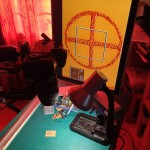 I’ve recently had the need to solder some small components at home, but don’t have a microscope, or even a decent magnifying glass. But then I thought that I’d a rather expensive DSLR and a pretty good macro lens, along with some extension tubes (allows closer focussing). Now I know that the camera has a Live-View facility (it’s a Canon 5D Mark III), but would the display be output easily to a monitor? Well, in the box that came with the camera, I found a cable which had a composite connector and some kind of A/V connector for the camera, so I set it up as shown in the pictures, a switched on the camera. The menu was displayed on the monitor, as hoped. Once I’d enabled live view and adjusted the settings so the exposure was OK, I zoomed into the display, first x5 and then x10. Each time the live view display was replicated on the monitor.
I’ve recently had the need to solder some small components at home, but don’t have a microscope, or even a decent magnifying glass. But then I thought that I’d a rather expensive DSLR and a pretty good macro lens, along with some extension tubes (allows closer focussing). Now I know that the camera has a Live-View facility (it’s a Canon 5D Mark III), but would the display be output easily to a monitor? Well, in the box that came with the camera, I found a cable which had a composite connector and some kind of A/V connector for the camera, so I set it up as shown in the pictures, a switched on the camera. The menu was displayed on the monitor, as hoped. Once I’d enabled live view and adjusted the settings so the exposure was OK, I zoomed into the display, first x5 and then x10. Each time the live view display was replicated on the monitor.
The following image shows a pad that I want to solder. If anything, the view is too close!
And just as a kind of reference to see what kind of magnification I’m actually getting, here’s another image with a 3.3mm circular feature on the PCB.
So the monitor object is 3.5mm across, and displays on the monitor at 250mm, so that’s a magnification of 70:1. Awesome. And as you can see from the pics, the camera is well away from the working area, so plenty of room to work… 🙂
So, now all I need is a decent soldering iron to let me do a decent job on those small components. 🙂
Edit: As mentioned by Didier in the comments, below, it’s a good idea to blow or suck the fumes from the solder away, not just for your owwn health, but also for the health of the front element of the lens! 🙂 A small fan or vacuum cleaner should do the job.



Hi David,
Should I suggest the use of a small fan to blow out the “smoke” that will result from your soldering job (melting of the welding material) ?
This will prevent your expensive photography equipment, at least the front lens of your macro lens, to be “polluted” by this smoke.
Regards,
Didier.
Good point Didier. I’ve been using a vacuum cleaner with the hose mounted just beside the work area, it’s not mentioned in the article above. Works quite effectively, although it’s a bit noisy. I’m looking at looking at one of those heating fans with the heating element disabled, much quieter, and just as effective. Dave.
I was thinking of using a vacum cleaner too but I have limited space around my work area. I ended up using an old 80mm PC case fan and soldered it to an old 5v cellphone charger. Its quiet, small and provides just enough airflow to blow the fumes away from my face. 🙂
+1. if ever a setup needs an A1 filter, this is it. That macro lens is too valuable to let solder and flux splash on it.
Too true, Pat. A UV filter or similar dedicated to the job would be a good idea. I’ll get my hands on one before doing actual soldering using this setup… 🙂
Dave.